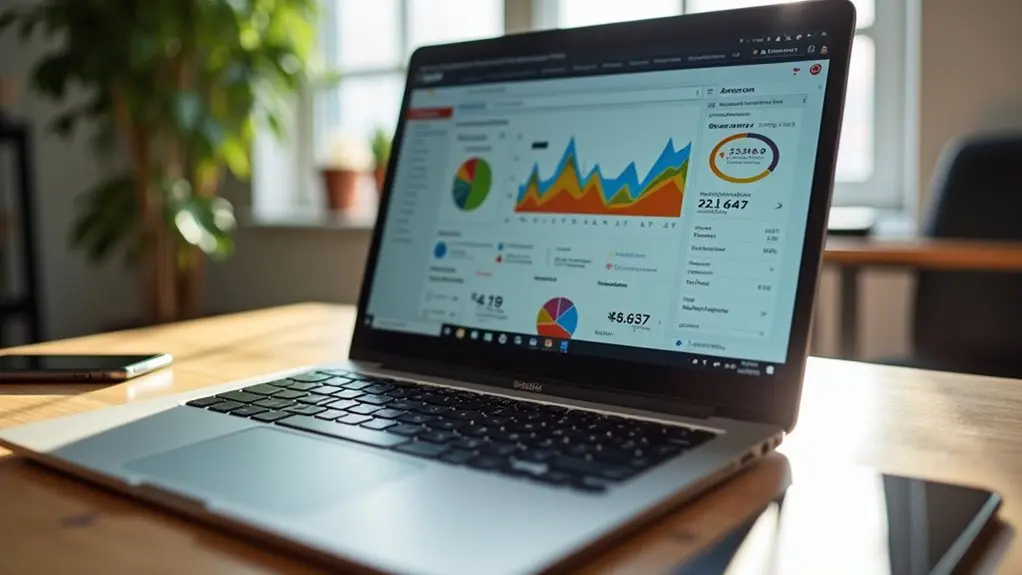Amazon Aggregators are firms that acquire and scale multiple Amazon FBA brands, particularly those generating at least $1 million in annual revenue. They focus on optimizing operations and brand visibility to drive profitability, targeting brands with 15% or higher profit margins. With major players like Thrasio and Perch, these aggregators typically value businesses at 3-6 times their annual pre-tax profits. Post-acquisition, they apply strategies like expanding product lines, enhancing brand identity, and utilizing data analytics to boost growth. Selling to an aggregator offers a quick exit and competitive offers. Exploring more will reveal the nuances of their operations.
Key Takeaways
- Amazon aggregators are firms that acquire and grow Amazon FBA brands to optimize operations and increase profitability.
- They focus on established private label brands with at least $1M annual revenue or $20K net profit.
- Post-acquisition, they broaden product lines, use data analytics, and enhance brand visibility.
- Aggregators prefer brands in evergreen niches with high product ratings and positive reviews.
- Selling to aggregators offers a quick exit, competitive valuations, and access to scaling resources.
Understanding Amazon Aggregators
When it comes to understanding Amazon aggregators, you're diving into a rapidly evolving sector of e-commerce that's reshaping the marketplace landscape.
Amazon aggregators are specialized firms focused on acquiring and scaling multiple Amazon FBA brands. They target established brands, particularly those operating under a private label business model. By optimizing operations and enhancing brand visibility, these aggregators aim to boost profitability and market presence.
The acquisition process is strategic, with aggregators seeking businesses that generate at least $1 million in annual revenue or $20,000 in net profit. These criteria guarantee a robust customer base and potential for growth.
Aggregators typically prefer private label brands over wholesale or retail arbitrage, as these offer greater control over the customer experience and product branding.
In terms of valuation, businesses are generally acquired for 3-6 times their annual pre-tax profits. However, post-consolidation, the potential for higher multiples exists, reflecting improved efficiencies and synergies.
Collectively, these firms have raised about $13 billion, with top players accounting for nearly 70% of the funding. This influx of capital underscores strong investor confidence in the aggregator business model, offering lucrative opportunities for those considering selling their business.
Key Players in the Market
Amazon aggregators have reshaped the e-commerce landscape, and now it's crucial to understand the key players driving this transformation. Thrasio, founded in 2018, stands out as a pioneer among Amazon aggregators, with over 100 acquisitions and a valuation of $1 billion. Their thorough 500+ checkpoint evaluation process sets a high bar for the acquisition process. Perch, another major player, targets established FBA brands with at least $1 million in annual revenue, focusing on optimizing existing operations to scale brands effectively on the e-commerce platform.
| Aggregator | Key Focus/Strategy |
|---|---|
| Thrasio | 100+ brand acquisitions, $1B valuation, rigorous evaluation |
| Perch | Brands with $1M+ revenue, operational optimization |
| Unybrands | Cash-upfront deals, international scaling |
| Benitago | $3M+ revenue, product focus with price matching |
Unybrands specializes in specific product categories, offering cash-upfront deals and aiming to scale brands internationally. Benitago, on the other hand, requires a minimum revenue of $3 million, providing a unique product focus and price matching bonuses to attract potential sellers. Merama takes a different approach by acquiring stakes rather than full ownership, primarily in Latin America, with a goal to enhance brands to a $1 billion valuation within 3-5 years. Understanding these key players provides insight into the dynamic strategies shaping the Amazon aggregators market today.
Criteria for Acquisition
Frequently, the success of an acquisition by Amazon aggregators hinges on a set of well-defined criteria. As an aspiring seller, understanding these benchmarks can increase your attractiveness to potential buyers.
Primarily, aggregators target established FBA brands that boast a minimum annual revenue of $1 million or an annual net profit of at least $20,000. This guarantees a solid financial foundation for scalability and growth within the Amazon marketplace.
Profit margins are another critical factor. Aggregators typically seek brands with a profit margin of 15% or higher, highlighting their potential for sustainable long-term growth. A smaller SKU range, averaging around 14 SKUs, allows for focused management and product optimization, making such brands appealing candidates for acquisition.
Private label branding is highly favored over wholesale or retail arbitrage models. This preference stems from the greater control over pricing and customer loyalty that private labels can offer.
Additionally, operating within evergreen niches guarantees consistent demand, further enhancing a brand's attractiveness.
Finally, high product ratings and positive reviews are essential, as they signify customer satisfaction and bolster the brand's reputation, ultimately making it a more desirable acquisition target for Amazon aggregators.
Post-Acquisition Strategies
Post-acquisition strategies are pivotal for guaranteeing the sustained success and growth of acquired brands within the competitive Amazon marketplace. As an aggregator, you'll plunge into optimization tactics to revamp product listings, enhance images, and launch targeted PPC campaigns. This approach not only improves visibility but also boosts conversion rates, directly impacting your revenue streams.
Here's how you can achieve this:
- Expand Product Lines: Leverage existing customer bases by broadening the product range, thereby capturing wider market demands and generating additional revenue streams.
- Utilize Data Analytics: Employ advanced data analytics to monitor sales trends and adjust marketing strategies. This guarantees continued growth and profitability, keeping your brand competitive.
- Integrate and Maintain Brand Identity: Carefully manage the integration of acquired brands to optimize operational efficiencies. This balance maintains brand identity and enhances customer loyalty and retention.
- Develop Tailored Growth Strategies: Assemble expert teams to craft customized growth strategies, focusing on maximizing profitability and scaling operations into international markets.
Benefits of Selling to Aggregators
After implementing strategic post-acquisition plans, the next logical step is to explore the advantages of selling to aggregators. Selling to Amazon aggregators can be a quick exit strategy, often finalizing the transaction process in under two months. This speed is possible because aggregators conduct thorough due diligence, simplifying the process for third-party sellers. They provide competitive offers, valuing businesses typically between $2 and $5 million, based on reliable revenue streams.
| Benefit | Description | Outcome |
|---|---|---|
| Quick Exit | Sales process under two months | Time-efficient |
| Competitive Offers | Valuations between $2M and $5M | Attractive financial outcomes |
| Operational Efficiencies | Access to resources for scaling businesses | Enhanced growth potential |
| Negotiating Power | Competition among buyers for better offers | Improved financial outcomes |
Aggregators bring resources and expertise that facilitate operational efficiencies, helping scale businesses post-acquisition. This means your business can reach new heights with enhanced growth potential. Additionally, by creating competition among multiple buyers, sellers can maximize their negotiating power, often leading to improved financial outcomes. Selling to aggregators offers a streamlined transaction process, less complex than traditional sales, thanks to clear financial documentation. These benefits make selling to aggregators a strategic choice for third-party sellers aiming for efficient exits and robust financial returns.
Frequently Asked Questions
What Do Aggregators Do?
You'll recognize aggregators by their business model focusing on acquisition strategy. They enhance operational efficiency through inventory management, seller support, and brand development. Using market analysis, they navigate the competitive landscape, leveraging funding sources for growth tactics.
How Do Ecommerce Aggregators Make Money?
You leverage acquisition strategies and investment strategies to enhance profit margins by optimizing operational efficiencies. Analyze market trends and competitive landscape to boost growth potential. Diverse revenue streams and risk management tactics guarantee sustainable business models and financial success.
Is Amazon an Aggregator or Marketplace?
You're analyzing Amazon's role, and you'll see it's a marketplace, not an aggregator. Marketplace dynamics let sellers optimize strategies for brand visibility, pricing, and inventory management. Aggregator advantages lie in scaling brands, enhancing customer experience, and analyzing competition.
What Is a Brand Aggregator?
You're looking at brand aggregators as entities that employ brand consolidation strategies, acquiring small brands to enhance scalability opportunities. They analyze market trends, face challenges in brand management, and impact consumer perception, using valuation methods amidst a competitive landscape.
Conclusion
You've seen how Amazon aggregators transform the e-commerce landscape by acquiring promising brands and optimizing their operations. With key players like Thrasio and Perch leading the charge, they apply stringent criteria for acquisitions and employ robust post-acquisition strategies. By selling to these aggregators, you gain access to operational expertise and financial resources, enhancing your brand's growth potential. Data shows that aligning with aggregators can markedly boost your brand's market presence and profitability, making it a compelling option for many sellers.




